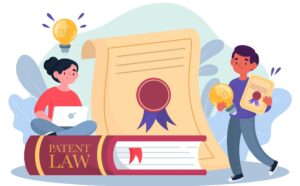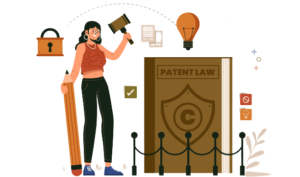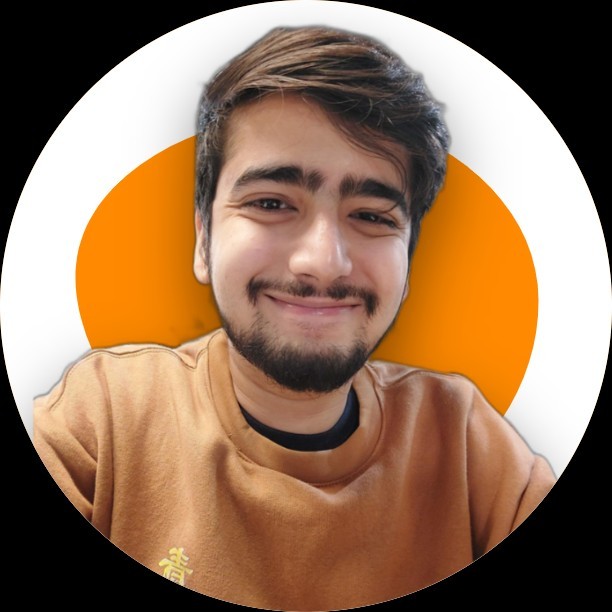The Basics: What Is A Patent?
A patent is a kind of intellectual property (licensed innovation) that gives its proprietor the legal right to keep others from utilizing, making, or selling an invention for a set timeframe. In certain countries, patent privileges are safeguarded by private regulation law, and that truly intends that to have their rights imposed, the patent holder should sue somebody who infringes on the patent. Licenses can give a significant competitive upper hand for firms.

Invention
A product or a process including a creative step that is equipped for industrial application can be characterized as an invention. One can get any invention rights by enlisting for a patent.
Patentable Inventions:
- Novel: It has no effect on how, by whom, or where the invention was made known. It should be novel. Regardless of whether one has utilized or distributed the invention, the invention is considered as in existence.
- One of a kind: An Invention should not have an existential hint of it beforehand. The new approaches for consolidating existing methods or objects and improvement in the current innovation aren’t patentable.
- Industrial Applicability: An innovation is considered patentable when it tends to be utilized, produced, manufactured, or used in any sort of industry.
Non-Patentable Inventions:
- Inventions that have no serious value/purpose and as opposed to natural laws.
- Inventions that conflict with public ethics.
- Creations that are a simple revelation of something that exists in nature already.
- The simple revelation of a form previously existing in nature doesn’t prompt improvement of viability.
- Simple admixing of blends leading in the collection of properties are non-patentable.
- Simple conglomeration or duplication of gadgets working in a known manner isn’t an invention.
- Agricultural or horticultural methods are non-patentable.
- Diagnostic, prophylactic, medicinal, remedial, and therapeutic for treating diseases in humans and animals are non-patentable.
- Fundamental biological cycles for the creation or propagation of animals and plants isn’t an invention, hence non-patentable.
- Basic numerical or business or PC programs are not considered an invention.
- Aesthetic creation isn’t an innovation.
- Mental act, rule, or technique isn’t an invention.
- Data Presentation is non-patentable.
- Incorporated circuits topography is non-patentable.
- Customary Knowledge doesn’t come under inventions.
- Nuclear Energy creations are non-patentable.

Patent Right: Is It An Absolute?
The right to a patent isn’t outright. It is a confined right that is dependent upon specific foreordained limits. The Patents Act finds some kind of harmony between the patentee’s rights and the public’s interest. The monopoly allowed by a patent isn’t outright. Alongside safeguarding the right-holder for his creation, the Act additionally thinks about the public’s interests, with the essential objective of the Act being to support the improvement of technology.
Can Anyone Apply For A Patent?
- A patent application can be documented by the true and first inventor or his assignee, alone or in collaboration with others or through an approved Patent Attorney.
- A legal delegate of a deceased individual can also record a patent application.
Kinds Of Patent Application:
- Provisional Application: A provisional application is an impermanent application recorded when an invention is in the testing phase and not fit to be documented yet.
- Standard or Non-Provisional Application: This kind of application is documented if the candidate has no claim to priority or if the application isn’t in response to a past convention application. It should be accompanied by a complete specification.
- Convention Application: A convention application is documented to guarantee a priority date because of an earlier application recorded in any of the convention countries that are identical or significantly comparable. To acquire convention status, a candidate should record an application with the Indian Patent Office within a year of the date on which a comparative application was first filed in the convention country.
- PCT International Application: A worldwide application is a PCT Application. The application doesn’t give the candidate a global patent, yet it does make the way for a streamlined patent application process in different countries all at once.
- PCT National Phase Application: A candidate is expected to record a national phase application in every country where protection is required. The deadline for recording the application is 31 months from the priority date or the worldwide filing date, whichever starts first.
- Patent of Addition: This application should be recorded assuming the candidate finds that they have come across an invention which is a slightly modified version of the creation which has effectively been applied for or patented by the candidate.
- Divisional Application: If a single application claims more than one invention, the candidate might decide to separate the application and submit two or more applications according to the candidate’s needs.

While Applying For A Patent, These Are The Procedure To Be Followed:
- Patent Attorneys are experts in the preparation and documentation of patent applications along with addressing clients in court in cases including patents like infringement, licensing, and re-examination.
- Each Applicant shall make an application for Patent in Form 1 (Application for an award of the patent) or Form 2 (Provisional/Complete specification), just for one invention alongside the evidence of the right to make the application.
- If the proof of the right to make the application isn’t prepared with the application, it shall be documented within a time of 6 months to the patent office.
- Within 48 months of the date of priority of the application or the date of documenting of the application, a solicitation for examination be filed for examination of the application.
- Following the release of the primary examination report, the candidate is offered the chance to respond to the report’s objections.
- The candidate must meet the necessities within 6 months of getting the main examination report, which might be extended out for 3 extra months at the candidate’s request.
- Assuming the candidate neglects to follow the requirements of the first examination report inside the period of 9 months, the application is considered abandoned.
- After all, objections have been tended to and all requirements have been met, the patent is granted and distributed in the Patent Office Journal.
Term Of A Patent
Each patent in India is valid for 20 years from the date of documenting, even if it is recorded with a provisional or complete specification. Each patentee should renew their patent consistently every year by paying a renewal charge. There is no renewal charge for the initial two years. From the third year onwards, the fee is expected. The patent will be revoked if the renewal fee isn’t paid. Following 20 Years Patents can’t be extended further and turn into a part of the public domain.

Post Patent Compliances
Restoration Of License
A patentee or his lawful delegate has the safeguard to restore a lapsed remaining in the patent by making an application in Form 15 alongside the renewable charges within 18 months from the date of lapse.
Foreign Filing License
- In the event that an Indian resident or Company means to record a patent outside India, they will have to get an authorization for example foreign filing license from Indian Patent Office first.
- The solicitation for making authorization for filing patent outside India is made in Form 25.
- An application for a patent for the same creation has been made in India, at least six weeks before the application outside India.
Intimation Regarding Patent Filed Outside India
- Each Applicant shall make a statement and undertaking in Form 3 inside a half year from the date of the recording of the application for patent outside India.
- The revelation of a statement containing subtleties of Country, candidate, and invention.
- Non-compliance of filing of Form 3 prompts revocation of Patent Applications.
Compulsory Licensing
- As opposed to the restrictive rights that are conferred on a patentee to utilize, make, or sell a patented invention and forestall unapproved and illicit use by outsiders, a mandatory license allows a third party to utilize, make, or sell a creation for which a patent has been granted without the assent of the patent owner.
- Following three years have passed since the patent was granted, any individual intrigued may submit an application to the Controller for the grant of a compulsory license on the accompanying grounds:
- the public’s reasonable prerequisites for the protected invention have not been met, or
- the protected invention isn’t accessible to the general public at a sensible cost, or
- the protected invention has not been functional in India’s territory.
- When the previously mentioned conditions are met, an individual who is now the holder of a patent license can apply to the controller for the award of a mandatory license.
Recent Developments
The Patents (Amendment) Rules, 2021 came into effect on September 21, 2021, with the following key changes:
- Union Government has reduced the patent recording and handling expenses that are imposed on educational establishments by approx 80%.
- The decrease in expenses is at par with comparative concession conceded to start-ups under the Start-up India initiative
- Indian as well as Foreign applicants can claim the status of eligible educational establishments now, by submitting a Declaration in Form 28.


